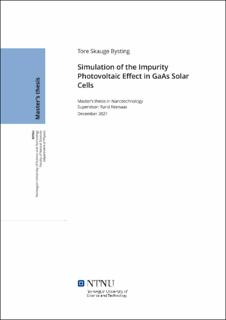| dc.description.abstract | I dette arbeidet, gjøres numeriske simuleringer for GaAs-solceller med dype urenheter. Slike urenheter fungerer typisk som ødeleggende rekombineringssentre. De kan imidlertid også muliggjøre optisk eksitasjon av ladningsbærere i en to-stegs prosess fra valensbåndet til urenhetsnivået og fra urenhetsnivået til ledningsbåndet, slik at ladningsbærerne bidrar til den fotogenererte strømmen. Dette er kjent som den urenhets-fotovoltaiske (engelsk: impurity photovoltaic, IPV) effekten og åpner opp for å utnytte en større del av den innkommende strålingen, siden også fotoner med energi lavere enn materialets hoved-båndgap kan absorberes.
Programvaren for solcellesimulering kalt SCAPS brukes til simuleringene. I dette masterprosjektet evalueres først programvaren som et verktøy for simulering av IPV-effekten. Den vurderes til å være en egnet programvare for slike simuleringer. SCAPS har en bred funksjonalitet, også når det gjelder IPV-effekten. Resirkulering av fotoner er imidlertid ikke inkludert.
Etter dette brukes SCAPS til å studere påvirkningen en gruppe material- og designparametere har på solcelle-ytelsen. Disse parameterne inkluderer foto-ioniserings-tverrsnittene, tverrsnittene for termisk fangst, urenhetstype, grunn bakgrunnsdoping og lysfanging. Foto-ioniserings-tverrsnittene må varieres over flere størrelsesordener for å ha en betydelig påvirkning på celle-ytelsen. Tverrsnittene for termisk fangst varieres også logaritmisk og har stor påvirkning på celle-ytelsen. En egnet kombinasjon av urenhetstype og tetthet av grunn bakgrunnsdoping har potensiale til å forbedre celle-ytelsen. En høy grad av lysfanging er essensiell for at gevinsten av IPV-effekten skal være større enn den økte rekombineringen assosiert med de dype urenhetene.
Av alle solcellene som er simulert i dette arbeidet (med unntak av én celle hvis kredibilitet svekkes av numeriske problemer) er den høyeste oppnådde konverteringseffektiviteten 33.5 %. Dette oppnås for en celle med maksimal lysfanging og akseptor-type dype urenheter som er delvis kompensert av donor-type grunn bakgrunnsdoping. En lignende celle uten dype urenheter har en effektivitet på 28.2 %. Hvis maksimal lysfanging kan oppnås, indikerer dette et stort potensial for solceller med IPV-effekt. Effektiviteten avtar imidlertid drastisk ved dårligere lysfanging. | |
| dc.description.abstract | In this work, numerical simulations are performed for GaAs solar cells into which deep level impurities are introduced. Such impurities typically act as detrimental recombination centers. However, they can also enable charge carriers to be optically excited in a two-step process from the valence band to the impurity level and from the impurity level to the conduction band, thereby contributing to the photogenerated current. This is known as the impurity photovoltaic (IPV) effect and opens up for utilizing a wider range of the incident radiation, as also photons with energy lower than the main band gap of the cell material can be absorbed.
The solar cell simulation software SCAPS is used for the simulations. In this master project, this software is first evaluated as a tool for simulation of the IPV effect. It is found to be a suitable software for such simulations. SCAPS has a broad functionality, also when it comes to the IPV effect. The mechanism of photon recycling is, however, not included.
Subsequently, SCAPS is used to study the influence of a set of material and design parameters on the performance of the solar cells. These parameters include the photo-ionization cross sections, the thermal capture cross sections, the type of the impurities, shallow background doping and light trapping. The photo-ionization cross sections must be varied over several orders of magnitude to have a noteworthy impact on the cell performance. The thermal capture cross sections are also varied in a logarithmic manner and have a large influence on the cell performance. A suitable combination of impurity type and shallow background doping density has the potential to improve the cell performance. Finally, a high degree of light trapping is found to be essential for the gain of the IPV effect to outweigh the increased recombination associated with the deep level impurities.
Of all the solar cells simulated in this work (except for one cell which credibility is reduced by numerical issues), the highest conversion efficiency obtained is 33.5 %. This is achieved for a cell with maximum light trapping and acceptor type deep level impurities, partly compensated by donor type shallow background doping. A similar cell with no deep level impurities is found to have an efficiency of 28.2 %. If maximum light trapping can be achieved, this indicates a great potential for solar cells with the IPV effect. However, the efficiency of the cells decreases drastically when poorer light trapping is applied. | |
